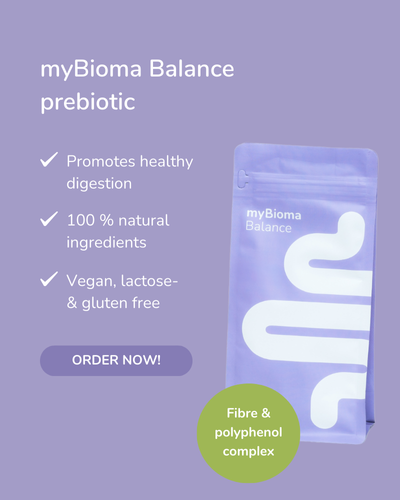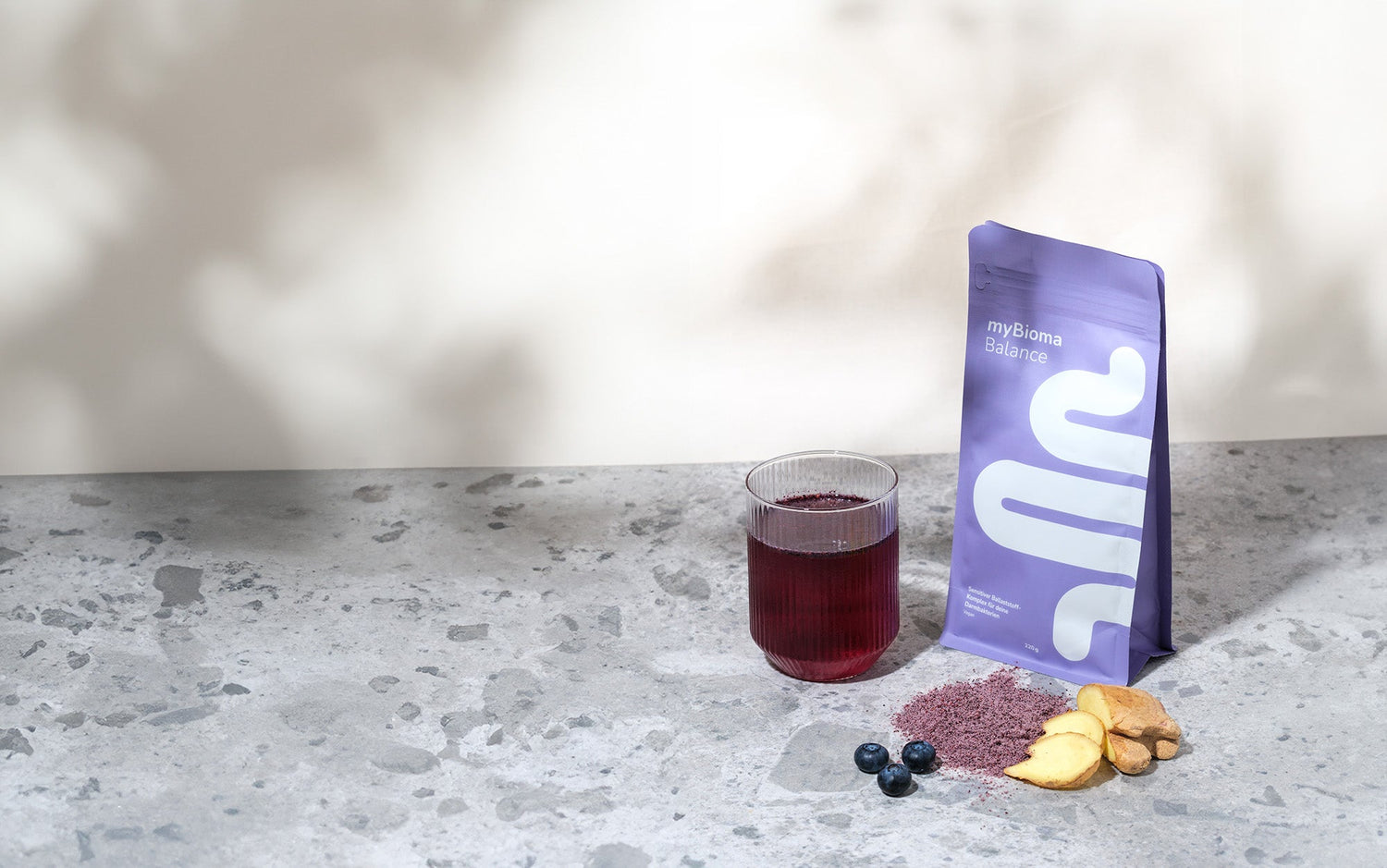Table of contents
- What are polyphenols?
- Different types of polyphenols and their classification
- Which foods contain the most polyphenols?
- How polyphenols work in the intestine
- Polyphenols and their role in colon cancer
- Influences on the polyphenol content in foods and their effect on your body
- Considerations when taking polyphenols
- Practical recommendations for the intake of polyphenols
What are polyphenols?
Polyphenols are secondary plant compounds found in many plant foods, such as fruits and vegetables, and are responsible for their vibrant colors, distinct smells, and flavors.
Secondary plant compounds are produced by plants but are not directly necessary for their growth or development. They primarily help plants ward off pests, protect against diseases, and adapt to environmental conditions.
For humans, polyphenols offer numerous health benefits. They have antioxidant, anti-inflammatory, antibacterial, and neuroprotective effects, among others (1). They also have prebiotic properties, meaning they promote the health of your gut microbiome (2).
When we consume polyphenols through food, only about 5-10% are absorbed in the small intestine and enter the bloodstream directly. They therefore have a very low bioavailability. Why, then, do they still have such significant effects on our health? The majority of polyphenols reach the large intestine, where the gut microbiome comes into play: intestinal bacteria convert these plant substances into bioactive compounds, which influence various processes in our bodies (1,3). But more on that later.
Different types of polyphenols and their classification
The colorful variety of polyphenols includes over 10,000 different compounds that have been intensively researched over the last 20 years. They can be divided into the following groups according to their chemical structure:
- Phenolic acids: These can be further divided into two main types, namely benzoic acid and cinnamic acid derivatives. The most common include ferulic acid (e.g. in cereals) and caffeic acid (found not only in coffee but also in many vegetables and fruits).
- Flavonoids: This is the largest group of polyphenols, which includes flavanones, isoflavones, chalcones, flavanols (e.g. catechins, proanthocyanidins), flavonols (e.g. quercetin and kaempferol), flavanonols and anthocyanins. They can be found in numerous fruits and vegetables, tea, cocoa, coffee and soy, among others.
- Polyphenolic amides: These are characterized by nitrogen in their functional group. Their most important representatives include capsaicinoids (in chilli) and avenanthramides (in oats).
- Other non-flavonoids: Mainly stilbenes (such as resveratrol in red grapes) , lignans (e.g. in flax seeds) and curcuminoids (in turmeric).
Sounds confusing? Luckily, we don't need to remember the complicated names when we're eating them. 😉
Now, let's take a closer look at some of the most important polyphenols:
1. Resveratrol
Resveratrol belongs to the stilbene category and is found in certain fruits such as grapes or berries, as well as in peanuts and pistachios. The content can vary greatly and depends on the individual varieties, environmental factors (e.g. soil, temperature, pest infestation) and the production process (e.g. in red wine). This polyphenol is said to have a wide range of health benefits, including antioxidant, anti-cancer, cardiovascular protective, anti-inflammatory, antidiabetic, anti-aging, anti-adipogenic and neuroprotective properties (3,4).
2. Curcumin
Curcumin is the main bioactive substance in the turmeric root and has a long tradition as a spice (e.g. ingredient in curry or golden milk), medicinal product and colorant. This polyphenol is said to have anti-inflammatory, antioxidant, blood sugar-lowering, wound healing, antimicrobial and anti-cancer properties, among others. There is also evidence that curcumin could counteract age-related neurodegenerative diseases such as Alzheimer's (2,3).
Tip: Always take turmeric in combination with black pepper (which contains the polyphenol piperine). This can increase the absorption of the active ingredient by up to 20 times (14).
3. Quercetin and rutin
Quercetin is a flavonol flavonoid that is mainly found in (red) onions, lettuce, peppers, red cabbage, black chokeberry (aronia), tomatoes, broccoli and apples. In food, quercetin is often found with a sugar compound and is then called rutin. Sources of rutin also include various fruits and vegetables such as onions, grapes, apples, berries, citrus fruits, asparagus, but also buckwheat and rooibos tea. Quercetin and rutin are said to have antioxidant, anti-inflammatory, anti-cancer, antibacterial, cardiovascular protective, anti-adipogenic and neuroprotective properties. In addition, rutin can be used as a supportive treatment option for some vascular diseases such as varicose veins, internal bleeding or hemorrhoids (3,4). Quercetin is also particularly known for promoting the proliferation of bifidobacteria in the intestine. Among other things, this can help inhibit potentially harmful intestinal bacteria and promote intestinal peristalsis. Quercetin and rutin are also associated with increased production of short-chain fatty acids in the intestine - important substances for many body processes and a healthy gut mucosa (2).
4. Kaempferol
Kaempferol is also a very common flavonol flavonoid. It is found in many fruits and vegetables, especially grapes (and red wine), berries and green leafy vegetables. The polyphenol is said to have the potential to counteract heart disease, obesity, type 2 diabetes, neurodegenerative diseases, cancer and atherosclerosis. Like most polyphenols, it also has antioxidant, antibacterial, antiviral and anti-inflammatory effects (4).
5. Isoflavones
The most important representatives of isoflavones are daidzein and genistein. They are mainly found in soybeans and their products such as tofu, tempeh, natto and soy yogurt, but also in red clover, for example. Due to their structure, they are classified as phytoestrogens. This means that they are similar in structure to the hormone estrogen and can bind to estrogen receptors. As a result, the intake of this polyphenol can be particularly beneficial during menopause and can counteract hot flashes and osteoporosis, for example. The effect depends on the natural estrogen level in the body: if there is little estrogen, isoflavones can have an estrogen-like effect and initiate corresponding body processes. If, on the other hand, there is already a lot of estrogen, isoflavones can downregulate the body's own estrogen production and have an anti-estrogenic effect. In addition, isoflavones are known for their antioxidant, anti-inflammatory and anti-cancer (especially breast cancer) activities (3).
Side note: Isoflavones are sometimes criticized for having negative effects on fertility or leading to "feminization" in men. However, scientific studies do not confirm these connections, but rather emphasize the health benefits of soy products and their ingredients such as isoflavones (3,5).
6. Proanthocyanidins
Proanthocyanidins are a type of flavonoid found in a wide variety of plant-based foods. Cinnamon bark, millet, grape seeds, chocolate, aronia berries, blueberries and hazelnuts are particularly rich in this polyphenol. Their health benefits include cardioprotective, antitumor, anti-inflammatory and antimicrobial properties (3). Proanthocyanidins are also known as dietary supplements in the form of OPC (oligomeric proanthocyanidins) or in grape seed extract. They are said to have particularly high antioxidant power (20 times stronger than vitamin E and 50 times stronger than vitamin C). The substance is particularly known for its anti-aging effects and for promoting the health, elasticity and flexibility of the skin, protecting against sun damage and having a positive effect on vision and the cardiovascular system (6).
7. Catechins
Catechins belong to the flavanol flavonoids. The best-known source of catechins (in the form of EGCG = epigallocatechin gallate) is green tea. The polyphenol is also found in apples, grapes, pears, cherries and cocoa powder, for example. Catechins are said to have antioxidant, heart-protective, anti-aging and anti-cancer properties (4). There is also evidence that EGCG can support the prevention and treatment of Alzheimer's and can have a positive effect on fat metabolism and the sleep-wake rhythm (2).

A selection of polyphenols and examples of foods that contain particularly high levels of them.
Which foods contain the most polyphenols?
To date, researchers have examined over 500 different polyphenols in foods for their chemical structure, bioavailability and potential health benefits. Determining the exact polyphenol content is difficult and information from the literature is often incomplete, contradictory and, not least due to different analysis methods, difficult to compare. Due to the complexity of this large group of plant substances, many polyphenols are still unknown. It should also be noted that the polyphenol content in different foods can vary greatly depending on the variety, cultivation and storage conditions. In order to provide the best possible overview, an international team of researchers has developed the comprehensive Phenol Explorer database and identified the 100 foods richest in polyphenols on the basis of numerous research results (7,8).
Accordingly, the best sources of polyphenols (per 100g of food) are the following (8):
| Spices and dried herbs | Cloves, star anise, peppermint, sage, oregano, rosemary, thyme |
| Cocoa bean | Cocoa powder and dark chocolate |
| Berries: mainly dark colored | Black chokeberry (Aronia), black elderberry, blueberry and black currant, blackberries |
| Fruit: here too, the more intense the colour, the more polyphenols are present | Plums and cherries, but also grapes, apples, peaches, pears and nectarines |
| Seeds and nuts | Flaxseed, chestnuts, walnuts, hazelnuts, pecans, almonds |
| Legumes | Mainly soybeans, but also all other types of beans and lentils |
| Vegetables | Especially black and green olives, artichoke heads, chicory, onions, shallots and spinach, but also broccoli, asparagus, potatoes, endive, lettuce and carrots |
| Beverages | Coffee, green and black tea, red wine |
| Grains | Not quite at the top of the list, but not to be underestimated are wholemeal flours made from wheat or rye, corn flour and oat flakes. |
| Oils | Extra virgin olive oil, rapeseed oil |
Much more important for everyday life, however, are the polyphenol contents in relation to typical portion sizes. Some foods, such as spices and herbs, may be particularly rich in polyphenols, but the amount consumed is only small. In relation to typical portion sizes, these are the top 20 polyphenol sources (8):
| 1. Black elderberry | 11. Plums |
| 2. Black chokeberries (Aronia) | 12. Raspberries |
| 3. black currants | 13. Flaxseed flour |
| 4. Blueberries | 14. Dark chocolate |
| 5. Artichokes | 15. Chestnuts |
| 6. Coffee | 16. Black tea |
| 7. Blueberries | 17. Green tea |
| 8. Cherries | 18. Naturally cloudy apple juice |
| 9. Strawberries | 19. Apples |
| 10. Blackberries | 20. Wholemeal rye bread |
In summary, it can be said that brightly colored fruit and vegetables, especially dark berries, are particularly great sources for polyphenols. But coffee, black tea and green tea are also good sources of the various protective substances. However, please be aware that caffeine is not well tolerated by everyone.
Note: Even though a glass of red wine contains valuable polyphenols, we advise against drinking alcohol – because alcohol can not only have a serious impact on your general health, but can also disrupt the balance of your gut microbiome (9).
Below you will find more tips for a polyphenol-rich diet.
How polyphenols work in the intestine
Due to their complex chemical structure and high molecular weight, polyphenols have a very low bioavailability (= how much of a substance can be absorbed by the body). Nevertheless, thanks to our hardworking gut bacteria, they have a high bioactivity (= the effectiveness of a substance or its breakdown products on biological processes in the body) (3,7).
Polyphenols only develop their full potential in the intestine. So far, 6 different ways are known:
1. Changes in the gut flora
Polyphenols can contribute to a healthy diversity (bacterial variety) and balance of your intestinal microbiome. Their intake suppresses pathogenic microorganisms such as Clostridium histolyticum and Clostridium perfringens, while beneficial bacteria such as lactobacilli and bifidobacteria can be increased. The extent to which bacteria are affected depends, among other things, on the type and amount of polyphenol consumed and on the initial state of the intestinal flora (1). In addition, a diet rich in polyphenols is associated with a positive change in the ratio of Firmicutes to Bacteroidetes, which serves as an important marker for the health of the intestinal flora and metabolism (2).
2. Increase the production of short-chain fatty acids
Components of plant foods that we cannot digest (fiber and polyphenols) are converted by certain intestinal bacteria into substances such as short-chain fatty acids. These are essential for a healthy gut (especially for an intact intestinal mucosa), for the function of numerous important processes in the body and for minimizing inflammation. Study results show, for example, that the flavonoid EGCG can increase the number of bacteria that produce short-chain fatty acids (1). Other polyphenols that are associated with increased production of short-chain fatty acids are chlorogenic acid, caffeic acid, rutin and quercetin (2).
3. Antibacterial effect against potentially harmful gut bacteria
Polyphenols can interfere with the function of the cell membrane of some types of bacteria. For example, studies show that a diet rich in polyphenols inhibits the growth of potentially harmful bacterial strains of salmonella, E. coli or staphylococci and certain types of clostridia, while the growth of beneficial bacteria such as lactobacilli is not affected (1). A well-known example is the effect of polyphenols in green and black tea for their inhibitory effect on the growth of pathogens and their positive effect on the composition of the intestinal microbiome. In addition, gut bacteria can lower the pH value of the intestinal tract by producing short-chain fatty acids. This creates an environment in which pathogenic bacteria feel uncomfortable and spread less (2).
4. Conversion into a variety of protective substances
Gut bacteria convert polyphenols into even smaller substances (for example vanillic acid, coumaric acid or urolithins), which then enter the bloodstream via the intestinal mucosa, are transported through the body and can perform various tasks. Among other things, they support your immune system and help protect against chronic diseases such as cancer, diabetes, cardiovascular and neurodegenerative diseases (1). The extent to which polyphenols can be converted in the gut and made available to the body depends significantly on the composition of the gut flora, which is influenced by diet, lifestyle, medication, environmental factors and age (2).
With a microbiome test from myBioma, you can find out how the composition of your gut flora affects your health and what measures you can take to actively support your gut bacteria in doing their important work optimally.
5. Influence on the gut-brain axis
The gut-brain axis connects the gut microbiome to the central nervous system via hormones, cytokines, and neurotransmitters. This constant communication between the gut and the brain, influenced by the metabolic products of gut bacteria, affects various diseases such as Alzheimer's, Parkinson's, multiple sclerosis, autism, depression, stress, schizophrenia, and anxiety.
Polyphenols can directly act as neurotransmitters, thereby enhancing cognitive performance and protecting the brain and nerves. They also indirectly protect the brain by promoting the production of beneficial metabolites by intestinal bacteria. These metabolites have antioxidant and anti-inflammatory properties, which are crucial for counteracting neurodegenerative processes (10).
6. Strengthening the gut mucosa
The intestinal mucosa, made up of tight cell junctions, controls which substances pass from the intestine into the bloodstream. Polyphenols can inhibit bacteria that degrade mucus cells, while enhancing the production of protective substances, such as short-chain fatty acids (10).
By regulating the permeability of the intestinal mucosa and exhibiting anti-inflammatory and immune-regulating properties, polyphenols can help mitigate conditions like leaky gut (11). For more information on leaky gut and its relationship with the gut microbiome, you can explore this blog post: Leaky Gut – and why a healthy gut barrier matters

A diet rich in polyphenols comes with a variety of health benefits.
Polyphenols and their role in colon cancer
Polyphenols, such as EGCG, resveratrol, curcumin, and quercetin, are known for their anti-tumor properties. They can potentially reduce the risk of various cancers, particularly colon cancer, and may assist in treatment. Research indicates that these compounds can influence critical signaling pathways in cancer cells, which are essential for their growth and survival.
Additionally, polyphenols might enhance the effectiveness of conventional treatments by reducing drug resistance in tumor cells and minimizing chemotherapy's side effects. However, many questions remain about the precise impact of polyphenols on colon cancer, including their exact mechanisms, safe and effective therapeutic strategies, and potential interactions with other drugs and within the body (12,13).
Influences on the polyphenol content in foods and their effect on your body
1. Origin:
In addition to the variety, the polyphenol content in plant-based foods depends on their growing conditions, such as climate and soil quality. Organic farming tends to promote higher polyphenol levels (14).
2. Preparation methods (14):
-
Drying: Methods such as freeze-drying extend the shelf life of foods and prevent microbial contamination. However, this process can result in the loss of polyphenols because it damages plant cells, allowing enzymes to break down these compounds.
-
Grinding: Grinding can destroy polyphenols by activating enzymes that break them down. Nevertheless, if grinding is done at low temperatures or after blanching, it can enhance the availability of polyphenols, as smaller food particles are more accessible to digestive enzymes.
-
Heat: Heat can both destroy polyphenols and facilitate their release. For instance, heating can soften cell walls, making polyphenols more available during digestion. This is beneficial in tomatoes, where heating has a positive effect. Conversely, heat-treated fruit juices often show a reduction in polyphenol content.
3. Food matrix (14,15)
- Dietary fiber: Dietary fiber can decrease the bioavailability of polyphenols by binding to them, which means fewer polyphenols directly enter the bloodstream. However, more polyphenols may reach the large intestine and exert their effects there. The impact varies depending on the type of dietary fiber and polyphenol. The exact mechanisms are not fully understood.
- Fat content of food: Oils can improve the absorption of certain polyphenols because some of these compounds are lipophilic (fat-soluble). Fat in the food helps dissolve these polyphenols, allowing them to be more easily absorbed into the bloodstream through micelle formation, similar to vitamins A, D, E, and K. This effect is especially well-documented for curcumin and some flavonoids like quercetin.
- Proteins: Proteins may negatively affect polyphenol availability, although research findings are mixed. The impact depends on the type of protein, the specific polyphenols, and the overall composition of the food.
- Other Antioxidants and Polyphenols: Antioxidants like vitamins E and C, as well as other polyphenols, may enhance the absorption of polyphenols. For example, piperine from black pepper is known to improve the absorption of curcumin. However, effects vary among different polyphenols, and more research is needed to understand these complex interactions fully.
Considerations when taking polyphenols
Consuming polyphenols through normal dietary patterns is generally safe and beneficial. However, be aware of potential interactions with medications. Some polyphenols can influence the activity of cytochrome P450 enzymes, which are crucial for metabolizing drugs (7). Consult a healthcare professional if you have concerns about interactions.
There is speculation that, similar to other antioxidants like vitamin C, polyphenols might have pro-oxidative effects under certain conditions. This means they could potentially reduce the body’s own antioxidant defenses (4). There is also evidence that high levels of certain polyphenols could reduce the absorption of various minerals and trace elements such as iron, zinc, copper and sodium (14). Dietary supplements should therefore not be taken beyond the recommendations.
The interactions between polyphenols and various components in our diet are not fully understood. More research is needed to clarify how polyphenols affect the body in different conditions, beyond controlled laboratory settings.
Practical recommendations for the intake of polyphenols
In order to benefit from the broad spectrum of polyphenols and their positive effects on your health, it is worth consuming as many different plant-based foods as possible.
You might have heard of the “Eat the Rainbow” concept, which encourages consuming a diverse range of colorful fruits and vegetables. This approach not only makes your meals visually appealing but also helps increase your intake of various valuable polyphenols.

eat colorfully - live healthily
A good rule of thumb is that the more vibrant the color, the higher the polyphenol content. Berries, in particular, are notable for their high polyphenol levels, so make sure to enjoy these nutritious fruits more often for to boost your health.
Polyphenols are excellent for gut health due to their prebiotic effects and anti-inflammatory properties. That’s why polyphenol-rich wild blueberries and ginger are ingredients in our prebiotic myBioma Balance. This dietary supplement is designed to help you easily boost your polyphenol and fiber intake. It’s also gentle on sensitive digestive tracts. You can order the fiber and polyphenol complex here: myBioma Balance - Premium Prebiotic.
References
- Wang X, Qi Y, Zheng H. Dietary polyphenol, gut microbiota, and health benefits. Antioxidants. June 20, 2022;11(6):1212.
- Liu S, Cheng L, Liu Y, Zhan S, Wu Z, Zhang X. Relationship between dietary polyphenols and gut microbiota: new clues to improve cognitive disorders, mood disorders and circadian rhythms. Foods. March 19, 2023;12(6):1309.
- Luca SV, Macovei I, Bujor A, Miron A, Skalicka-Woźniak K, Aprotosoaie AC, et al. Bioactivity of dietary polyphenols: The role of metabolites. Crit Rev Food Sci Nutr. February 21, 2020;60(4):626–59.
- Rasouli H, Farzaei MH, Khodarahmi R. Polyphenols and their benefits: A review. Int J Food Prop. December 29, 2017;20(sup2):1700-41.
- Mörixbauer A. Soy, soy isoflavones and health effects. Part 1. Nutritional Review. 15 March 2019;(66(3)):M160–9.
- Shi J, Yu J, Pohorly JE, Kakuda Y. Polyphenolics in Grape Seeds—Biochemistry and Functionality. J Med Food. December 2003;6(4):291–9.
- Bertelli A, Biagi M, Corsini M, Baini G, Cappellucci G, Miraldi E. Polyphenols: From Theory to Practice. Foods. November 2021;10(11):2595.
- Pérez-Jiménez J, Neveu V, Vos F, Scalbert A. Identification of the 100 richest dietary sources of polyphenols: an application of the Phenol-Explorer database. Your J Clin Nutr. November 2010;64(S3):S112–20.
- Engen PA, Green SJ, Voigt RM, Forsyth CB, Keshavarzian A. The Gastrointestinal Microbiome. Alcohol Res Curr Rev. 2015;37(2):223–36.
- Chatterjee A, Kumar S, Roy Sarkar S, Halder R, Kumari R, Banerjee S, et al. Dietary polyphenols represent a phytotherapeutic alternative for gut dysbiosis associated neurodegeneration: A systematic review. J Nutr Biochem. Jul 1, 2024;129:109622.
- Peron G, Gargari G, Meroño T, Miñarro A, Lozano E, Escuder P, et al. Crosstalk among intestinal barrier, gut microbiota and serum metabolome after a polyphenol-rich diet in older subjects with “leaky gut”: The MaPLE trial. Clin Nutr. September 1, 2021;40.
- Ding S, Xu S, Fang J, Jiang H. The Protective Effect of Polyphenols for Colorectal Cancer. Front Immunol [Internet]. 10 July 2020 [cited 19 June 2024];11. Available at: https://www. frontiersin.org/journals/immunology/articles/10.3389/fimmu.2020.01407/full
- Long J, Guan P, Hu X, Yang L, He L, Lin Q, et al. Natural Polyphenols as Targeted Modulators in Colon Cancer: Molecular Mechanisms and Applications. Front Immunol [Internet]. February 16, 2021 [quoted June 19, 2024];12. Available at: https://www.frontiersin.org/journals/immunology/articles/10.3389/fimmu.2021.635484/full
- Bohn T. Dietary factors affecting polyphenol bioavailability. Nutr Rev. July 1, 2014;72(7):429–52.
- Kamiloglu S, Tomas M, Ozdal T, Capanoglu E. Effect of food matrix on the content and bioavailability of flavonoids. Trends Food Sci Technol. November 2021;117:15–33.







